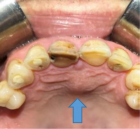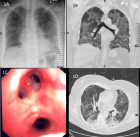Abstract
Research Article
Antiuropathogenic and antioxidant activities of Hypoxis hemerocallidea Lam. extracts, and compounds from its taxonomically related species
Kokoette Bassey* and Sekelwa Cosa
Published: 22 January, 0020 | Volume 4 - Issue 1 | Pages: 001-009
Hypoxis hemerocallidea Lam is one of the 43 Hypoxis species in South Africa, marketed extensively as over the counter herbal product for the management of several diseases. The plant commercial products link efficacy to hypoxoside 4, its aglycone (rooperol), or β-sitosterol. This study investigated antibacterial and anti-oxidant activities of four other molecules and two extracts from the Hypoxis plant. Visual antioxidant limit of detection and free radical scavenging activities of test samples were determined using 20 mM hydrogen peroxide, 0.4 mM DPPH or ferric reducing antioxidant power assay. Quantitative free radical was determine by spectrophotometric method while antibacterial activity was evaluated using MICs against uropathogens: S. aureus (ATCC25923), S. marcescens (ATCC 14041), P. aeruginosa (ATCC 9721), P. mirabilis (ATCC 33583) and E. coli (ATCC 10536).
Anti-oxidant activities visual limit of detection of 0.06 mg/mL and percentage free radical scavenging activity (IC50 = 0.048 - 0.032 mg/ml) for pure compounds 1 - 4 and (IC50 = 0.037 - 0.039 mg/ml) for extracts were obtained. The reducing power IC50 ranged between 0.15 - 0.23 mg/ml for extracts and 0.11-0.35 mg/ml for standards. Antibacterial potentials show a noteworthy to moderate MIC values of 0.20 - 1.56 mg/ml against S. aureus (ATCC 25923), S. marcescens (ATCC 14041), P. aeruginosa (ATCC 9721), P. mirabilis (ATCC 33583) and E. coli (ATCC 10536). Galpinoside 5, hemerocalloside 3 and curculigoside C 2 are the other active compounds in Hypoxis plant.
Read Full Article HTML DOI: 10.29328/journal.apps.1001020 Cite this Article Read Full Article PDF
Keywords:
Antibacterial; Antioxidant; Galpinoside; Hemerocalloside; Uropathogen
References
- Mills E, Cooper C, Seely D, Kanfer I. African herbal medicines in the treatment of HIV: Hypoxis and Sutherlandia. An overview of evidence and pharmacology. Nutr J. 2005; 4: 1-6. PubMed: https://www.ncbi.nlm.nih.gov/pubmed/15927053.
- Drewes SE, Hall HJ, Learmonth RA, Upfold UJ. Isolation of hypoxoside From Hypoxisrooperi and synthesis of [E]-1,5-bis[3,4-dimethoxyphenyl] pent-4-en-1-yne. Phytochem. 1984; 23: 1313-1316. https://www.sciencedirect.com/science/article/abs/pii/S0031942200804495
- Oguntibeju OO, Meyer S, Aboua YG, Goboza M. Hypoxis hemerocallidea Significantly Reduce hyperglycaemia and hyperglycaemic-induced oxidative stress in the liver and kidney tissues Of streptozotocin-induced diabetic male Wistar rats. Evid.-Based Complementary Altern Med. 2016; 2016: 1-10.
- Ojewole JAO. Antinociceptive, anti-inflammatory and anti-diabetic properties Of Hypoxis hemerocallidea Fisch., C.A. Mey. (Hypoxidaceae) corm [African potato] Aqueous extract in mice and rats. J Ethnopharmacol. 2006; 103: 126-134. PubMed: https://www.ncbi.nlm.nih.gov/pubmed/16191469
- Laporta O, Perez-Fons L, Mallavia R, Caturla N. Isolation, characterization and antioxidant capacity assessment of the bioactive compounds derived from Hypoxis rooperi corm extract (African potato). Food Chem. 2007; 101: 1425-1437. https://www.sciencedirect.com/science/article/pii/S0308814606002925
- Marini-Bettolo GB, Nicoletti PM, Galeffi C. Research on African medicinal plants-II: Hypoxoside a new glycoside with uncommon structure from Hypoxis obtusa busch. Tetrahedron. 1982; 38: 1683-1687. https://www.sciencedirect.com/science/article/abs/pii/0040402082801476
- Galeffi C, Multari G, De Vicente Y, Messan I, Nicolleti M, Marini-Bettolo GM. Two New Glucosides from Hypoxis obtusa: Obtuside A and Obtuside B. Planta medica. 1989; 55: 318-320. https://www.thieme-connect.com/products/ejournals/abstract/10.1055/s-2006-962019?device=mobile
- Van Staden J. Constituents of Hypoxis rooperi, a valuable medicinal plant in South Africa. Deutsche Apotheke Zeitung. 1989; 33: 460-464.
- Bassey K, Viljoen A, Combrinck S, Choi YH. New phytochemicals From the corms of medicinally important South African Hypoxis species. Phytochem Lett. 2014; 10: lxix–lxxv. https://www.sciencedirect.com/science/article/abs/pii/S1874390014001748
- Bitew A, Molalign T, Chanie M. Species distribution and antibiotic susceptibility profile of bacterial uropathogens among patients complaining urinary tract infections. BMC InfectDis. 2017; 17: 1-8. PubMed: https://www.ncbi.nlm.nih.gov/pubmed/28962545
- Tabibian JH1, Gornbein J, Heidari A, Dien SL, Lau VH. et al. Uropathogens and host characteristics. J Clin Microbiol. 2008; 46: 3980-3986. PubMed: https://www.ncbi.nlm.nih.gov/pubmed/18842936
- Foxman B, Barlow R, D'Arcy H, Gillespie B, Sobel JD. Urinary tract infection: self-reported incidence and associated costs. Ann Epidemiol. 2000; 10: 509-15. PubMed: https://www.ncbi.nlm.nih.gov/pubmed/11118930
- Foxman B. Epidemiology of urinary tract infections: incidence, morbidity, and Economic costs. Am J Med. 2002; 113: 5-13. PubMed: https://www.ncbi.nlm.nih.gov/pubmed/12113866
- Mon MM, Maw SS, Oo ZK. Quantitative determination of free radical scavenging activity and antitumor activity of some Myanmar herbal plants. Int Sch Sci Res Inn. 2011; 5: 92-98. http://www.ipcbee.com/vol11/22-T046.pdf
- Pauw E, Eloff JN. Which tree orders in southern Africa have the highest antimicrobial activity and selectivity against bacterial and fungal pathogens of animals? BMC Complement Altern Med. 2014;14: 1-12. PubMed: https://www.ncbi.nlm.nih.gov/pubmed/25164197
- Bredenkamp MW, Drewes SE, Wentler GL. A geraniol glycoside from Hypoxisacuminata. Phytochem. 1989; 28: 263-265. https://www.sciencedirect.com/science/article/abs/pii/0031942289850538
- Van Vuuren S. Antimicrobial activity of South African medicinal plants. J Ethnopharmacol. 2008; 119: 462-472. PubMed: https://www.ncbi.nlm.nih.gov/pubmed/18582553
- Nsibande BE, Gustavsson K, Zhu L. Analysis of health-associated Phytochemical compounds in seven Hypoxis species. AJPS. 2018; 9: 571-583. https://pdfs.semanticscholar.org/949d/3e30c54269cc6579ae3cfcb7e8c271b9ddef.pdf
- Mannathoko N, George S, Souda S, Chabaesele K, Goercke I. An in vitro Analysis of the antioxidant and antimicrobial properties of the methanol extract of Hypoxis hemerocallideacorm (MEHHC) from Botswana. MRJI. 2017; 19: 1-12. https://scite.ai/reports/an-in-vitro-analysis-of-the-N593dw
- Lundberg WO, Halvorson HO, Burr GO. The antioxidant properties of nordihydroguaiaretic acid. Oil & Soap. 1994; 21: 33-35. https://link.springer.com/article/10.1007/BF02593156
- Nair VDP, Dairam A, Agbonon JT, Arnason BCF, Kanfer I. Investigation of the antioxidant activity of African potato (Hypoxis hemerocallidea). J Agric Food Chem. 2007; 55: 1707-1711. https://pubs.acs.org/doi/abs/10.1021/jf0619838
- Katerere DR, Eloff JN. Anti-bacterial and anti-oxidant activity of Hypoxis hemerocallidea (Hypoxidaceae): Can leaves be substituted for corms as a Conservation strategy? SAJB. 2008; 74: 613-616. https://www.sciencedirect.com/science/article/pii/S025462990800197X
- Matotoka MM, Masoko P. Evaluation of herbal concoctions sold at Gamaja (Limpopo Province) in South Africa and in vitro pharmacological evaluation of plants used to manufacture the concoctions. J Evid Based Complem Altern Med. 2017; 22: 805-815. https://www.ncbi.nlm.nih.gov/pmc/articles/PMC5871308/
- Wu D, Wang H, Tan J, Wang C, Lin H, et al. Pharmacokinetic and metabolism studies of curculigoside C by UPLC-MS/MS and UPLC-QTOF-MS. Molecules. 2019; 24: 21. PubMed: https://www.ncbi.nlm.nih.gov/pmc/articles/PMC6337338/
Figures:

Figure 1

Figure 2

Figure 3

Figure 4

Figure 5

Figure 6
Similar Articles
-
Antiuropathogenic and antioxidant activities of Hypoxis hemerocallidea Lam. extracts, and compounds from its taxonomically related speciesKokoette Bassey*,Sekelwa Cosa. Antiuropathogenic and antioxidant activities of Hypoxis hemerocallidea Lam. extracts, and compounds from its taxonomically related species. . 0020 doi: 10.29328/journal.apps.1001020; 4: 001-009
-
Medicinal plant extract associated with bacterial cellulose membrane: Antibacterial activity and physicochemical propertiesFernando Batain,Kessi Crescencio,Thais Alves,Juliana Ferreira Souza,Venâncio Amaral,Juliana Castro,Carolina Santos,Angela Jozala,Luciane Lopes*,Marco Chaud*. Medicinal plant extract associated with bacterial cellulose membrane: Antibacterial activity and physicochemical properties. . 2020 doi: 10.29328/journal.apps.1001022; 4: 013-020
-
Metabolic profiling and antibacterial activity of Eryngium pristis Cham. & Schltdl. - prospecting for its use in the treatment of bacterial infectionsLaura Silva Fernandes,Ygor Ferreira Garcia da Costa,Martha Eunice de Bessa,Adriana Lucia Pires Ferreira,José Otávio do Amaral Corrêa,Glauciemar Del-Vechio Vieira,Orlando Vieira de Sousa,Ana Lúcia Santos de Matos Araújo,Paula C Castilho*,Maria Silvana Alves*. Metabolic profiling and antibacterial activity of Eryngium pristis Cham. & Schltdl. - prospecting for its use in the treatment of bacterial infections. . 2021 doi: 10.29328/journal.apps.1001027; 5: 020-028
-
Pefloxacin and its derivative, novel inhibitors of the SARS-CoV-2 Main protease (3CLpro) and their pharmacokinetics prediction: An in silico analysisEmmanuel Oluwaseun Adediran*. Pefloxacin and its derivative, novel inhibitors of the SARS-CoV-2 Main protease (3CLpro) and their pharmacokinetics prediction: An in silico analysis. . 2022 doi: 10.29328/journal.apps.1001030; 6: 013-018
-
Antibacterial Screening of Lippia origanoides Essential Oil on Gram-negative BacteriaRodrigo Marcelino Zacarias de Andrade, Bernardina de Paixão Santos, Roberson Matteus Fernandes Silva, Mateus Gonçalves Silva*, Igor de Sousa Oliveira, Sávio Benvindo Ferreira, Rafaelle Cavalcante Lira. Antibacterial Screening of Lippia origanoides Essential Oil on Gram-negative Bacteria. . 2024 doi: 10.29328/journal.apps.1001053; 8: 024-028.
-
Cardioprotective Potentials of Anacardium occidentale Nuts Methanolic Extract in Diabetes-Induced Cardiac Dysfunction in RatsFolasade Omobolanle Ajao*, Noheem Olaoluwa Kalejaiye, Marcus Olaoye Iyedupe, Sunday Abiodun, Joy Gbadero, Pelumi Ogundele, Zainab Adeagbo, Oluwatosin Ojolo, Enitan Shonde, Funmilayo Elizabeth Olaleye. Cardioprotective Potentials of Anacardium occidentale Nuts Methanolic Extract in Diabetes-Induced Cardiac Dysfunction in Rats. . 2024 doi: 10.29328/journal.apps.1001057; 8: 056-066
-
Nanoencapsulated Extracts from Leaves of Bauhinia forficata Link: In vitro Antioxidant, Toxicogenetic, and Hypoglycemic Activity Effects in Streptozotocin-induced Diabetic MiceBárbara Verônica Cardoso de Souza, Alessandra Braga Ribeiro*, Rita de Cássia Meneses Oliveira, Julianne Viana Freire Portela, Ana Amélia de Carvalho Melo Cavalcante, Esmeralda Maria Lustosa Barros, Luís Felipe Lima Matos, Tarsia Giabardo Alves, Maria. Nanoencapsulated Extracts from Leaves of Bauhinia forficata Link: In vitro Antioxidant, Toxicogenetic, and Hypoglycemic Activity Effects in Streptozotocin-induced Diabetic Mice. . 2024 doi: 10.29328/journal.apps.1001063; 8: 100-115
-
In vitro, Anti-oxidant, and Anti-inflammatory Activity of Kalanchoe pinnataWijeratne Mudiyanselage Swarna Menu*. In vitro, Anti-oxidant, and Anti-inflammatory Activity of Kalanchoe pinnata. . 2025 doi: 10.29328/journal.apps.1001064; 9: 001-008
-
Green Synthesis of Citrus sinensis Peel (Orange Peel) Extract Silver Nanoparticle and its Various Pharmacological ActivitiesJ Bagyalakshmi,M Prathiksha. Green Synthesis of Citrus sinensis Peel (Orange Peel) Extract Silver Nanoparticle and its Various Pharmacological Activities. . 2025 doi: 10.29328/journal.apps.1001065; 9: 009-013
Recently Viewed
-
A Gateway to Metal Resistance: Bacterial Response to Heavy Metal Toxicity in the Biological EnvironmentLoai Aljerf*,Nuha AlMasri. A Gateway to Metal Resistance: Bacterial Response to Heavy Metal Toxicity in the Biological Environment. Ann Adv Chem. 2018: doi: 10.29328/journal.aac.1001012; 2: 032-044
-
Obesity in Patients with Chronic Obstructive Pulmonary Disease as a Separate Clinical PhenotypeDaria A Prokonich*, Tatiana V Saprina, Ekaterina B Bukreeva. Obesity in Patients with Chronic Obstructive Pulmonary Disease as a Separate Clinical Phenotype. J Pulmonol Respir Res. 2024: doi: 10.29328/journal.jprr.1001060; 8: 053-055
-
Current Practices for Severe Alpha-1 Antitrypsin Deficiency Associated COPD and EmphysemaMJ Nicholson*, M Seigo. Current Practices for Severe Alpha-1 Antitrypsin Deficiency Associated COPD and Emphysema. J Pulmonol Respir Res. 2024: doi: 10.29328/journal.jprr.1001058; 8: 044-047
-
Navigating Neurodegenerative Disorders: A Comprehensive Review of Current and Emerging Therapies for Neurodegenerative DisordersShashikant Kharat*, Sanjana Mali*, Gayatri Korade, Rakhi Gaykar. Navigating Neurodegenerative Disorders: A Comprehensive Review of Current and Emerging Therapies for Neurodegenerative Disorders. J Neurosci Neurol Disord. 2024: doi: 10.29328/journal.jnnd.1001095; 8: 033-046
-
Metastatic Brain Melanoma: A Rare Case with Review of LiteratureNeha Singh,Gaurav Raj,Akshay Kumar,Deepak Kumar Singh,Shivansh Dixit,Kaustubh Gupta*. Metastatic Brain Melanoma: A Rare Case with Review of Literature. J Radiol Oncol. 2025: doi: 10.29328/journal.jro.1001080; 9: 050-053
Most Viewed
-
Evaluation of Biostimulants Based on Recovered Protein Hydrolysates from Animal By-products as Plant Growth EnhancersH Pérez-Aguilar*, M Lacruz-Asaro, F Arán-Ais. Evaluation of Biostimulants Based on Recovered Protein Hydrolysates from Animal By-products as Plant Growth Enhancers. J Plant Sci Phytopathol. 2023 doi: 10.29328/journal.jpsp.1001104; 7: 042-047
-
Sinonasal Myxoma Extending into the Orbit in a 4-Year Old: A Case PresentationJulian A Purrinos*, Ramzi Younis. Sinonasal Myxoma Extending into the Orbit in a 4-Year Old: A Case Presentation. Arch Case Rep. 2024 doi: 10.29328/journal.acr.1001099; 8: 075-077
-
Feasibility study of magnetic sensing for detecting single-neuron action potentialsDenis Tonini,Kai Wu,Renata Saha,Jian-Ping Wang*. Feasibility study of magnetic sensing for detecting single-neuron action potentials. Ann Biomed Sci Eng. 2022 doi: 10.29328/journal.abse.1001018; 6: 019-029
-
Pediatric Dysgerminoma: Unveiling a Rare Ovarian TumorFaten Limaiem*, Khalil Saffar, Ahmed Halouani. Pediatric Dysgerminoma: Unveiling a Rare Ovarian Tumor. Arch Case Rep. 2024 doi: 10.29328/journal.acr.1001087; 8: 010-013
-
Physical activity can change the physiological and psychological circumstances during COVID-19 pandemic: A narrative reviewKhashayar Maroufi*. Physical activity can change the physiological and psychological circumstances during COVID-19 pandemic: A narrative review. J Sports Med Ther. 2021 doi: 10.29328/journal.jsmt.1001051; 6: 001-007

HSPI: We're glad you're here. Please click "create a new Query" if you are a new visitor to our website and need further information from us.
If you are already a member of our network and need to keep track of any developments regarding a question you have already submitted, click "take me to my Query."

















































































































































